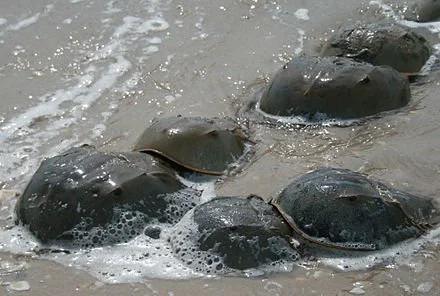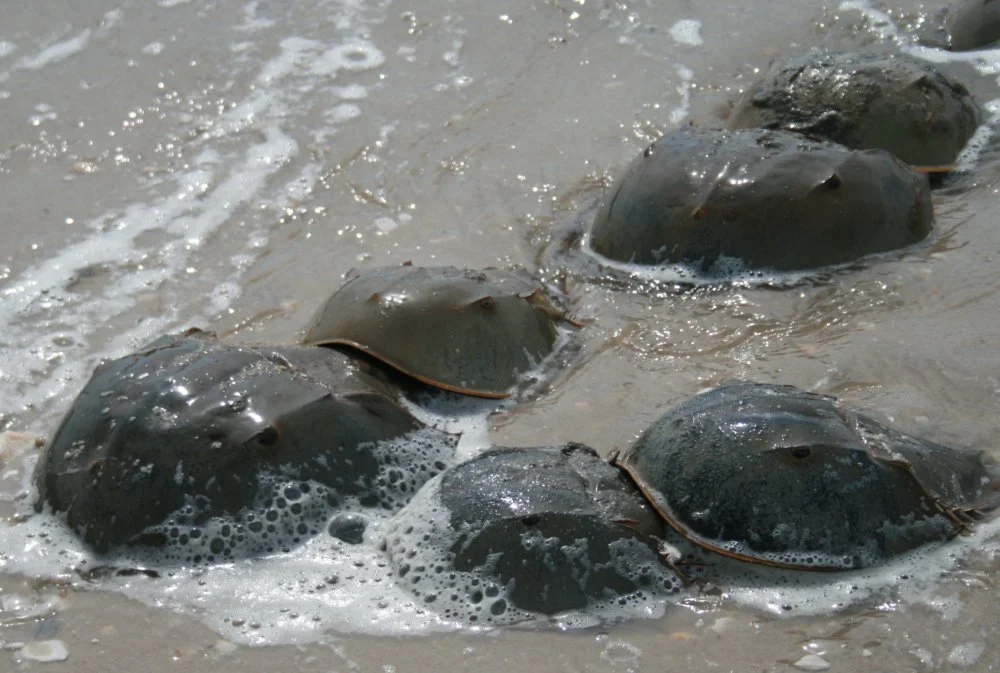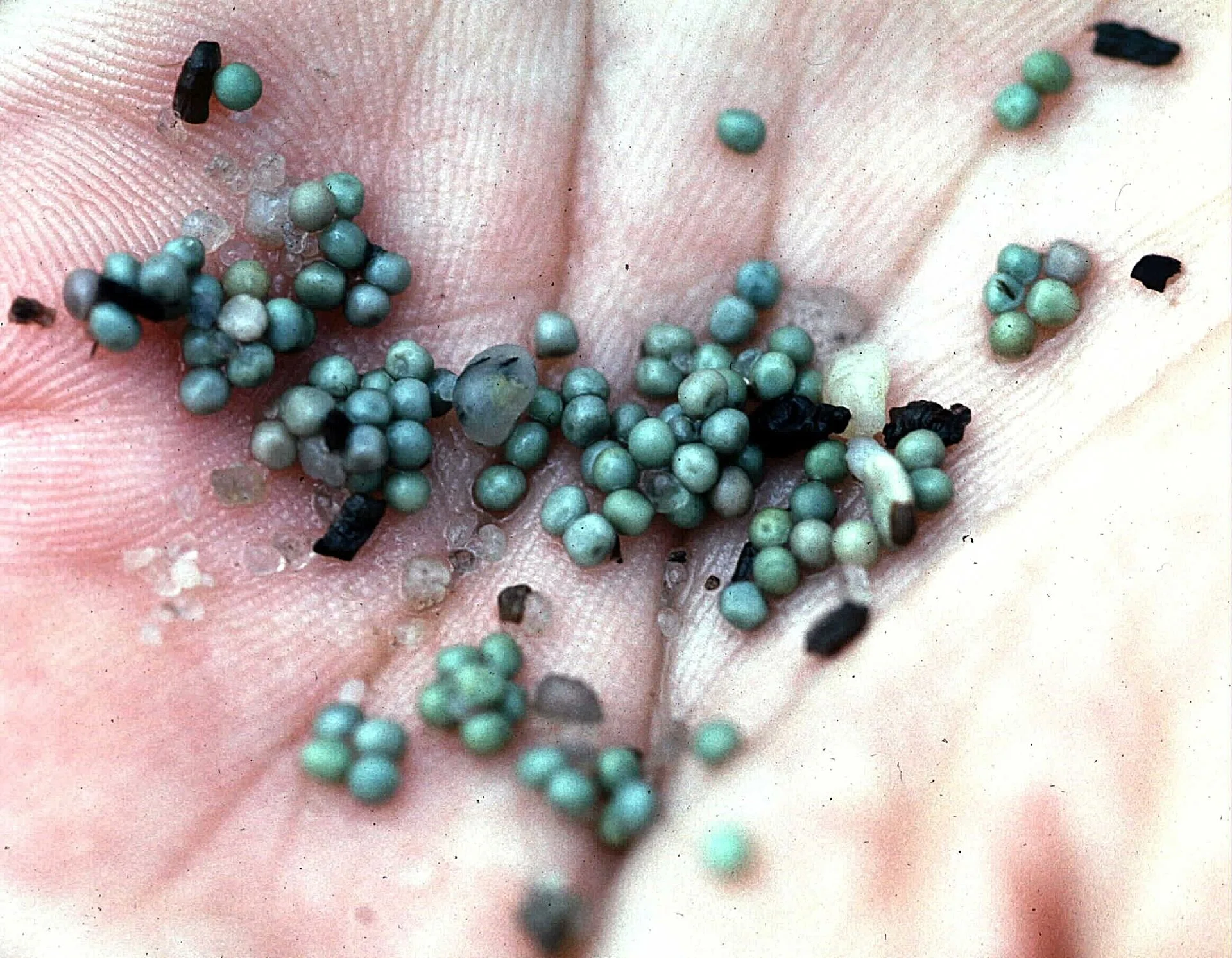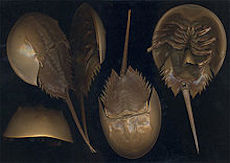
Trying to save horseshoe crabs
Horseshoe crabs mating.
Edited from a ecoRI News article by Frank Carini
“Ancient creatures with 12 legs, 10 eyes, and blue blood were once so prevalent on southern New England beaches that people, including children, were paid to kill them.
“Their helmet-like bodies can still be seen along the region’s coastline and around its salt marshes, but in a fraction of the numbers witnessed seven decades ago. There are several reasons why.
“In the 1950s coastal New England paid fishermen and others bounties to kill the up to 2-feet-long arachnids — horseshoe crabs are more closely related to spiders, scorpions and ticks than to crabs — because they interfered with human enjoyment of the shore and were viewed as shellfish predators….
“People, not just fishermen, were reportedly encouraged to toss horseshoe crabs above the high-tide line, so they would dry out and die. They were labeled ‘pests’ and ground up for fertilizer. Beachfront property owners were apparently concerned the creature’s presence and their decaying death would impact real estate values.
{Horseshoe crabs are harvested for their blood’s medical applications.}
“Those ignorant days may be over, but horseshoe crabs are facing other threats to their existence.’’
“The Center for Biological Diversity, an Arizona-based nonprofit, and 22 partner organizations recently petitioned NOAA Fisheries to list the Atlantic horseshoe crab as an endangered species under the Endangered Species Act….’’
To read the whole article, please hit this link.
Blue gold
Horseshoe crabs mating. Horseshoe crabs live primarily in and around shallow coastal waters on sandy or muddy bottoms. They tend to spawn in the intertidal zone at spring high tides.
Adapted from Robert Whitcomb’s “Digital Diary,’’ in GoLocal24.com
When I was a small boy living along Massachusetts Bay, we used to pick up and fling those brown, helmet-shaped and scary-looking, but harmless, arthropods on the lower beach called horseshoe crabs into the water and sometimes even at each other. Little did we know that this species, which goes back almost half a billion years, would become an important bio-medical resource, so much so that, along with habitat destruction, including ocean acidification caused by man-made global warming from burning fossil fuel, the species is endangered in many places.
Horseshoe crabs, by the way, are not crabs. Rather, they’re related to spiders and other arachnids.
For some years, drug companies have been harvesting the bluish blood of the creatures in New England and other places on the East Coast for a protein that’s used to identify dangerous bacteria during new-drug testing, including vaccines.
So important is horseshoe-crab blood that its value is estimated to be $15,000 a quart.
While pharm companies assert that most horseshoe crabs survive after they’re milked and then returned to the water, many die as a result, and over-harvesting is a distinct threat to the future of the species. Of course, everything in nature is connected and wiping out horseshoe crabs will imperil other species.
Consider that they play an important role in the food web for migrating shorebirds, finfish and Atlantic loggerhead turtles.
So let’s hope that environmental regulators pay close attention to the horseshoe-crab population.
They remind us that, with ever-developing scientific knowledge, some previously mostly ignored species turn out to be very important to people and to the wider web of life that humans depend on – a web that people are destroying at an accelerating rate. The more species we can save, the better for us.
Even horseshoe crabs’ eggs are bluish.
Abbey Greene: Horseshoe crabs being bled to death
By ABBEY GREENE, for ecoRI News
Horseshoe crabs are a marine arthropod found along the Atlantic coast from northern Maine to the Gulf of Mexico. Delaware Bay supports the largest spawning population in the world.
Older than dinosaurs, horseshoe crabs have survived plenty. But human impact may be the threat that could wash them out of the Atlantic.
For more than 350 million years, these living fossils have crawled ashore underneath the light of a full moon and laid their eggs in the sand. These hard-shelled crustaceans are a keystone species, making them vital to the ecosystem. Their eggs are a critical food source for many migratory shorebirds, and their ocean floor walks rototill the bottom, keeping the seafloor healthy.
The Atlantic States Marine Fisheries Commission reports that horseshoe crabs were hunted heavily from the 1800s to the early 1900s, with catches averaging from 1 to a whopping 5 million crabs a year. Total catch numbers dwindled over time, all the way down to 42,000 crabs by the 1960s. However, millions more were being harvested unreported and at a detriment to the horseshoe crab’s survival.
Bob Prescott, sanctuary director at the Massachusetts Audubon Society’s Wellfleet Bay Wildlife Sanctuary, said the sanctuary’s research into the ecosystem importance of horseshoe crabs began in 1999. Some fisheries didn’t see the benefit of horseshoe crabs at the time, and were more concerned with, say, their clam harvest than anything else.
“There was virtually no oversight by the (Massachusetts) Division of Marine Fisheries, and all of the shellfish departments and shellfish wardens were happy to get rid of this predator from their systems, thinking they’d get more clams,” Prescott said. “But, as we now know, the horseshoe crab is a really important part of the ecosystem, and you may even end up with less clams with less horseshoe crabs.”
By 2001, state-by-state harvest quotas were required by the Atlantic States Marine Fisheries Commission Horseshoe Crab Management Plan, and harvests have decreased in an effort to save the crabs.
Today, these crabs have two big threats looming over their oddly shaped heads. Horseshoe crabs are a popular bait for conch and eel fishermen, and they are wanted for their blood. Horseshoe crab blood is used for biomedical research and product manufacturing involving the detection of gram-negative bacteria, which can be harmful to humans.
Overfishing is the species’ primary threat, according to Scott Olszewski, marine biologist at Rhode Island Department of Environmental Management (DEM). He said a stock assessment taken in 2012 indicated that the Mid-Atlantic stock was stable, but the southern New England stock had low abundance.
Not only do horseshoe crabs need to worry about being hunted, but their habitat is also being taken away. Mark Faherty, science coordinator at the Wellfleet Bay Wildlife Sanctuary, said, “A lot of beaches in certain parts of the Cape have been really impacted by stonewalls people put up, and they totally disrupt the natural sand movement, and the beaches end up getting scoured away. That means spawning grounds for horseshoe crabs, piping clovers, heron ... all these species that use the edge of the beach no longer have habitat. There sort of are regulations to prevent habitat loss, but there is not enough and a lot of damage has been done.”
However, actions have been taken to help the horseshoe crab population recover. In southern New England, there are catch limits, and if a limit is reached, the fishery is closed for the season. Furthermore, every May, June and July, two days before and after new moons, fisheries are closed to harvest.
“It is peak spawning activity around the highest tides,” Olszewski said. “The idea is that peak spawning is going to take place then, so for 10 days each month we ensure some level of uninterrupted spawning.”
Combined with the addition of a few sanctuaries on the coasts of Rhode Island and Massachusetts, the populations are expected to bounce back over time. So far, no change has been seen.
There has, however, been some legal pushback in Massachusetts to enlist the horseshoe crab as endangered.
“The state is saying that we have this four hundred-crab limit,” Prescott said, “we have these no-harvest windows, so why don’t we see what happens and if the crab populations will respond to these restrictions. But the problem is we have to wait ten years, and we can’t wait 10 years.”
Olszewski is hoping for a legislative change soon in Rhode Island. There is a total annual catch reported in Rhode Island, but no daily catch limit. Not only would a daily catch limit make fishing more fair to all fishermen but it also could help remove some of the pressure on the horseshoe crab population, he said.
He said this idea could be put into effect as soon as the 2016 fishing season, after a public hearing process and approval is received from the Rhode Island Marine Fisheries Council and the DEM.
“I think the populations can come back in certain places, like Chatham,” Faherty said. “There is no harvest there, so the horseshoe crabs have a sort of sanctuary. There are thousands of juvenile crabs and adult crabs there, and it shows how it used to be. It shows us what it could be like and that the populations can really come back. It may just take some time, and work from us.”




